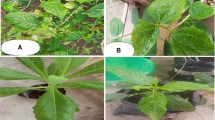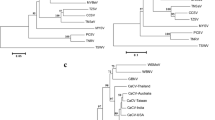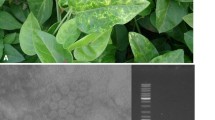Abstract
Capsicum chlorosis virus (CaCV) is emerging as economically important tospovirus, being a recently identified virus its complete host range was still not completely known. Virus infected leaves of amaranth plants grown in the vicinity of Capsicum fields showing characteristic symptoms of tospoviruses were collected, confirmed by tospovirus group specific antibody for the presence of a tospovirus and then the presence of CaCV was confirmed by virus specific antibodies. Nucleocapsid protein (NP) specific primer were used for amplification of NP gene and amplified cDNA products were confirmed by sequencing that the virus infecting amaranth was an isolate of CaCV. A comparison of the NP sequence with other isolate confirmed that it was 100 % similar to the reported Indian isolate of CaCV. To best of our knowledge this is the first report of natural infection of CaCv in Amaranthus sp. in India.
Similar content being viewed by others
Avoid common mistakes on your manuscript.
Amaranthus sp. are known to be infected with 121 viruses [2]. According to one report, the members of Amaranthaceae are susceptible to tomato spotted wilt virus [2]. Tospoviruses have been documented as serious pathogens of different crops worldwide. They are enveloped viruses having tripartite genome containing large (L), medium (M) and small (S) segments. Worldwide more than 20 tospoviruses have been reported [3]. Chillies with five tospovirus species were reported from India [3]. Amaranthus species serve as experimental hosts to a number of viruses, but only a few have been reported to infect them naturally.
During a survey, Amaranth was found in vicinity of infected chilies fields having symptoms of curling and chlorosis of its leaves (Fig. 1a, b). Suspected sample was first checked for the presence of tospovirus using group specific DAS-ELISA kit (Bioreba, New Zealand) and secondly with ELISA kits specific for TSWV and GBNV/CaCV. Positive reaction was only obtained with GBNV/CaCV antibodies which suggested that amaranth plants were infected with CaCV and/or GBNV. Further confirmation was done thrice by RT-PCR using nucleocapsid protein (NP) gene (CP) specific primers of CaCV and GBNV. Amplification product of ~800 bp was only obtained in case of CaCV and no amplification was observed in case of GBNV (Fig. 1c). The amplified product was sequenced using CaCV NP reverse primer and the sequence of 736 bp was obtained. The sequence matches closely with other isolates of CaCV reported from Maharastra, India (Chilli isolates), Taiwan (orchid isolate) having more than 99 % identity. Phylogenetic analysis of Amaranth isolate with other CaCV and other tospoviruses reported from different parts of the world reconfirms that the tospovirus infecting Amaranth was an isolate of CaCV as it clustered closely with other known (FJ011449; CaCV-Ch-Pan isolate) Indian isolates of CaCV, having 100 % similarity (Fig. 1d). The sequence of amaranth isolate of CaCV was also submitted to EMBL database with accession No. HG917416. CaCV is recognized as an economically important virus reported from different parts of the world [1]. Amaranth is regarded as important natural weed host for thrips transmitted viruses from several parts of the world [4]. Present study confirms the presence of CaCV on Amaranth plant based on visual symptoms, serology and sequence analysis of nucleocapsid protein (NP) with other CaCV reported from different parts of the world. This study provides evidence that Amaranth is a natural host of CaCv from India.
Capsicum chlorosis virus (CaCv) infection in Amaranthus sp. a and b Showing leaf distortion and chlorosis of Amaranth leaves. c Showing amplification of nucleocapsid protein (NP) gene of the associated virus. i showing amplification of CaCV CP in positive control; ii showing no amplification with groundnut bud necrosis virus specific primers; iii negative control, respectively; iv showing CaCv NP gene amlification in Amaranthus sp. d showing phylogenetic analysis of CaCV NP (Amaranth isolates) with the other tospovirus isolates reported from different parts of the world
References
Chen TC Chang CA Kang YC Yeh SD Huang CH Chen CC. Identification of Capsicum chlorosis virus causing chlorotic spots and stripes on Calla Lily. J Taiwan Agric Res. 2012;61(1):64–74.
Costea M Tardif FJ. The Biology of Canadian Weeds 126. Amaranthus albus L., A. blitoides S. Watson and A. blitum L. Biology Faculty Publications. 2003;83:1039–66.
Mandal B, Jain RK, Krishnareddy M, Kumar NKK, Ravi KS, Pappu HR. Emerging problems subcontinent of tospoviruses (Bunyaviridae) and their management in the Indian. Plant Dis. 2012;96(4):468–79.
Persley DM Sharman M Thomas J Kay L Heisswolf S McMichael L. Thrips and Tospoviruses—a management guide. Department of primary industries and fisheries. 2007;2–18.
Acknowledgments
Authors are thankful to Dr Bikash Mandal, Indian Agricultural Research Institute for kindly providing GBNV/CaCV antibodies.
Author information
Authors and Affiliations
Corresponding author
Rights and permissions
About this article
Cite this article
Sharma, A., Kulshrestha, S. First report of Amaranthus sp. as a natural host of capsicum chlorosis virus in India. VirusDis. 25, 412–413 (2014). https://doi.org/10.1007/s13337-014-0212-1
Received:
Accepted:
Published:
Issue Date:
DOI: https://doi.org/10.1007/s13337-014-0212-1





